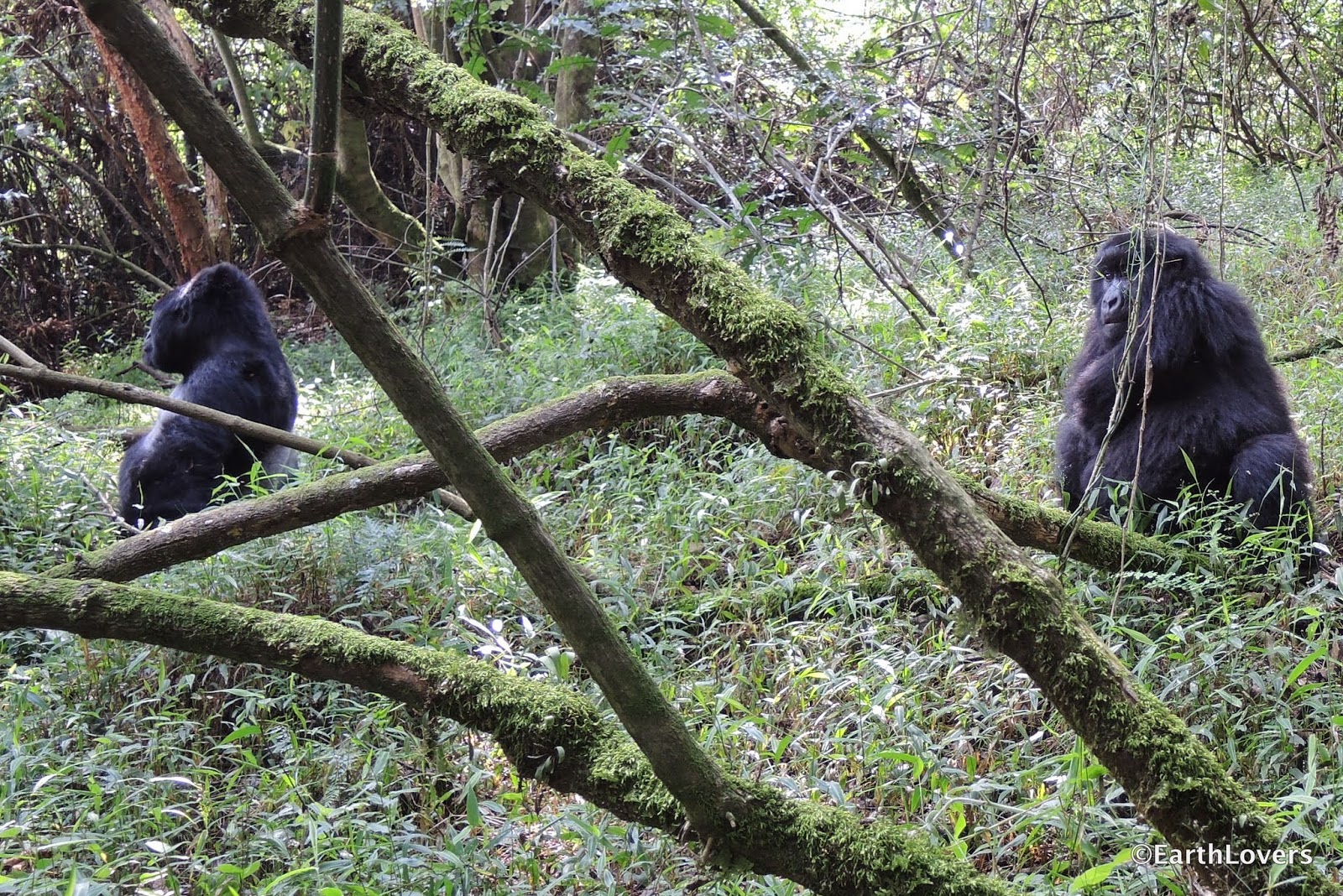 |
| Silverback Ndungutse, member of the Nyakagezi gorilla group in the Mgahinga Gorilla NP, Uganda Silberrücken Ndungutse aus der Nyakagezi Gorilla-Familie im Mgahinga Gorilla Nationalpark, Uganda |
 |
| A silverback and a juvenile of the Nyakagezi gorilla group Ein Silberrücken und ein "Teenager" aus der Nyakagezi Gorilla-Famile |
Did you know?
- The DNA difference between the gorilla and homo sapiens is just about 2%.
Thus it's not surprising that seeing the gorillas in their natural habitat is such a unique, unforgettable experience for us humans. - They have a lifespan of 30-40 years in the wild.
- There are roughly about 700 mountain gorillas (according to National Geographic) remaining on Earth, means they are critically endangered.
- Half of the world's remaining mountain gorilla population lives in the Virunga Mountains of Central Africa, at the intersection of Uganda, Rwanda and the Democratic Republic of the Congo. The other half lives just 24 km north of the Virunga Mountains, in Uganda's Bwindi Impenetrable National Park.
- You can do a gorilla trekking and see them in their natural environment - well, not all of them, since "just" 26 gorilla families are habituated to human presence.
- The rule: there is just one group of max. eight visitors allowed to visit one gorilla family per day...
- ... and for just one hour (there should not be too much contact with humans. Moreover gorillas are vulnerable to our diseases, since they have 98% of our genes. Hence you are not allowed to visit them if you are sick, and be it just a flu, for even this can be fatal for gorillas.)
- that is: max. 178 visitors = permits per day in all three countries (Uganda: 72, Rwanda: 80, DRC: 26)
- The price for a permit is USD600 in Uganda and DRC, in Rwanda even USD750. But it is good value! Aside from that the fees also benefit gorilla conservation.
Some more general information about the gorillas?
Great organization: Gorilla Doctors
National Geographic: "Virunga Gorillas"
BBC: "My other children, the orphan gorillas of Virunga"
The Dodo "Can One Documentary Save The Last Of The Mountain Gorillas In Virunga?"
Guide to Gorilla Trekking in Africa's Rainforests
 |
| Gorilla Doctors, a great Mountain Gorilla Veterinary project Gorilla Doctors, ein tolles Tierärzte-Projekt für die Berggorillas |
Die Berggorillas: 98% gleiche DNA wie wir Menschen
Habt ihr das gewusst?
- In nur 2% der DNA unterscheidet sich der Gorilla vom Homo Sapiens. Kein Wunder, dass ein Besuch bei ihnen für uns Menschen ein einmaliges, unvergessliches Erlebnis ist.
- Sie haben eine Lebenserwartung von 30 - 40 Jahren in der Natur.
- Es gibt nur noch ca. 700 Berggorillas (Zahlen von National Geographic) in der Welt - sie sind daher vom Aussterben bedroht.
- Sie leben ausschließlich in einem kleinen Gebiet Zentralafrikas: die eine Hälfte in der Virunga-Gebirgskette im Dreiländereck Uganda, Ruanda und Demokratische Republik Kongo, die andere Hälfte im nur 24 km nördlich der Virunga Berge gelegenen Bwindi Impenetrable National Park in Uganda.
- Man kann sie beim sog. Gorilla-Trekking in ihrem natürlichen Umfeld erleben, genau genommen nicht alle, sondern "nur" 26 Gorilla-Familien; die anderen bleiben ohne Kontakt zu Menschen.
- Die Regel: zugelassen ist nur 1 Gruppe mit max. 8 Besuchern pro Gorilla-Familie pro Tag...
- .. und für lediglich 1 Stunde (Sie sollen nicht zu sehr an Menschen gewöhnt werden. Außerdem sind sie aufgrund der 98%igen Verwandschaft mit uns leider auch sehr anfällig für unsere Krankheiten. Daher darf man sie nicht besuchen, wenn man krank ist. Das gilt auch schon für eine Erkältung, denn bereits sie könnte fatal sein für Gorillas.)
- Das bedeutet: max. 178 Besuche = Permits pro Tag (Uganda: 72, Ruanda: 80, DRC: 26)
- Ein Permit kostet inzwischen USD600 in Uganda und der DRC, in Ruanda sogar USD750. Doch ehrlich: Es lohnt sich jeder Dollar! Außerdem kommt das Geld auch dem Erhalt der Gorillas zugute.
Wollt ihr noch mehr über Gorillas wissen?
"Dian Fossey - Leben mit den Gorillas - Berggorillas in Not"
Bayerischer Rundfunk: "Gorillas sind akut gefährdet"
Zeit-Online "Virunga-Nationalpark: Keine Ölförderung im Wald der Berggorillas"
Rettet den Regenwald e.V. "Erfolg für die Berggorillas"
Blog: "Mgahinga Gorilla Nationalpark - Gorilla-Reisen in Uganda"
Großartige Organisation: Gorilla Doctors (englisch)


Keine Kommentare:
Kommentar veröffentlichen